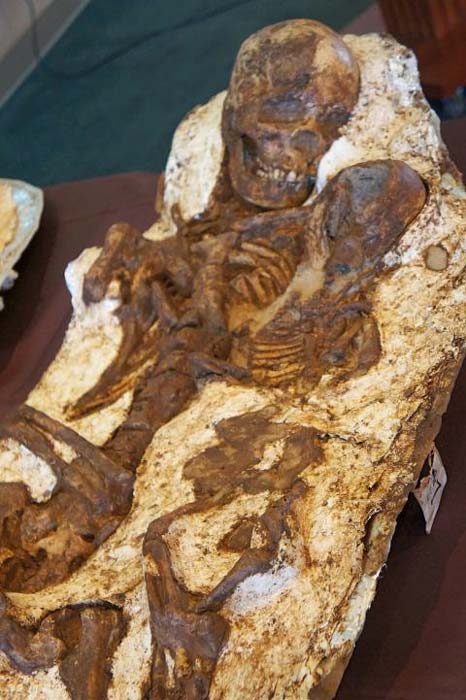
Mother Found Still Cradling Baby After 4800 Years
Oftentimes, few people are interested in the findings of archeological digs – broken pots, scattered bones, it usually takes a sign of cannibalism or extraordinarily old carbon dating to draw the mainstream media’s attention. Yet a Taiwanese discovery announced last year proved to be an exception to the rule. Photos of the exhumed bodies went viral and major news organizations from Fox News to the Huffington Post reported on the story. What was that discovery? A Stone Age skeleton of a mother cradling a baby in a shared grave.
The Origins of the Mummified Mother and Baby
The scientific excavation began in 2014 and took about a year to complete. A team of archaeologists led by Chu Whei-Lee of Taiwan’s National Museum of Science was working on a Neolithic site 6.2 miles (10 kilometers) inland from Taiwan’s western coast. Today, that area is called Taichung City but the site itself has been dubbed An-ho. Experts believe shorelines have shifted over the years and that An-ho was once a coastal village. Indeed, over 200 shark teeth have been found in the site’s dwellings, however, whether these teeth were practical, decorative, or spiritual is not known. The inhabitants of An-ho were most likely Dabenkeng people.
- The Love of a Mother Never Dies: 4,800-Year-Old Remains of a Mother Cradling Her Baby
- The ancient graves with couples in loving embrace
- The Mother of all Gods: The Phrygian Cybele
“The Dabenkeng people were the first farmers in Taiwan, who may have come from the south and southeast coasts of China about 5,000 years ago,” says Chengwha Tsang of Taiwan’s Academia Sinica. “This culture is the earliest Neolithic culture so far found in Taiwan.” (Drake, 2016) Taiwanese Dabenkeng culture featured corded ware pottery and stone adzes.

An example of corded ware pottery. (Einsamer Schütze/CC BY SA 3.0) Taiwanese Dabenkeng culture (to which experts believe the mother and baby belonged) featured corded ware pottery and stone adzes.
While the Dabenkeng lasted until the 3rd millennium BC on Mainland China, Taiwanese Dabenkeng lasted only until around 4,500 BC. Yet from Taiwan, the Dabenkeng spread across Southeast Asia and Oceania, bringing their culture and language with them. “They were probably the earliest ancestors of the Austronesian language-speaking people living nowadays in Taiwan and on the islands of the Pacific,” said Tsang (Drake, 2016).
- The Nurturing Goddess Ninsun: Worshipped by Ancient Mesopotamians and the Mother of Gilgamesh
- Five heart-warming and heart-breaking archaeological discoveries
- The Magical Tale of Mother Shipton: A Cave of Stories and Secrets
The Touching Find of the Mother and Baby
At An-ho, 48 graves were discovered, among them were five children. Most interesting of all was the shared grave of a mother looking down at a baby cradled in her arms. It is not clear how they died.

The remains of the young mother holding the baby. (National Museum of Natural Science)
“The young mother holding the baby surprised us most,” said team leader Chu Whei-Lee. “I guess they were buried under the house by their loved ones,” she adds, although more evidence is needed to support that idea (Drake, 2016). “When it was unearthed, all of the archaeologists and staff members were shocked. Why? Because the mother was looking down at the baby in her hands,” said Chu Whei-lee (Hamacher, 2016).
Further testing, including DNA analysis, of the mother and child as well of the other graves, is still ongoing. What we know already is that the mother was 5 feet 2 inches (160cm) tall and the baby was a foot and a half (50cm). Carbon dating puts their time of burial at about 4,800 years ago, putting them squarely in the island’s Stone Age. The bodies were interred in a typical north-south alignment. Unconventionally, they were laid on their backs (as opposed to being face down like the other graves at the site). Moreover, the mother’s face is titled to the right and downward so that she gazes upon the baby in her arms, even in skeleton form some 5000 years later.
Undoubtedly, this ancient maternal moment is what enabled the pair to become a modern-day viral sensation.
Top Image: The Stone Age remains of a mother cradling her baby. Source: Star2/Youtube Screenshot
Sources:
Drake, Nadia. "Stone Age Mother Found Cradling a Child in Shared Grave." National Geographic. National Geographic Society, 06 May 2016. Web. http://news.nationalgeographic.com/2016/05/160506-stone-age-mothers-day-fossils-taiwan/
Hamacher, Fabian. "Taiwan Finds 4,800-year-old Fossil of Mother Cradling Baby." Reuters. Thomson Reuters, 26 Apr. 2016. Web. http://www.reuters.com/article/us-taiwan-fossils-idUSKCN0XN1WI
Hung, Hsiao-chun. "A Sourcing Study of Taiwan Stone Adzes." Dabenkeng Culture. OMICS International, 2014. Web. http://research.omicsgroup.org/index.php/Dabenkeng_culture
Vintage News. "Mother Held Her Child for 4,800 Years -their Skeletons Found in Taiwan." The Vintage News. The Vintage News, 26 Nov. 2016. Web. https://www.thevintagenews.com/2016/11/26/mother-held-her-child-for-4800-years-their-fossils-found-in-taiwan-an-amazing-find-2/
















Comments
Seems they suffocated together down in the cavern, which seems to have a common fate of many ancient people where there are buried ruins. Suggests a global atmospheric event, probably associated with what caused the sudden emergence of the ice age (circa 120k BC) - aka the Atlantis event. Their death could also have been due to nuclear radiation, from fall-out. Either smoke or radiation (and certainly both) could create the subterranean conditions (sterile, dead zones) necessary for natural mummification, without which the bodies would have been consumed by bugs and microbes.
Nobody gets paid to tell the truth.
Two things stood out in this article; the skull of the woman was looking down at the child, not looking up like you would see in any other burial. And unlike the majority of the burials of these people they’re lying on their backs rather than on stomach facing down. This appeares to me that both were perhaps Buried Alive either as a sacrifice or as a punishment.
Such an act for either one or both reasons is well recorded in history. So why wouldn’t it happen in pre-history? Thanks for letting me post.